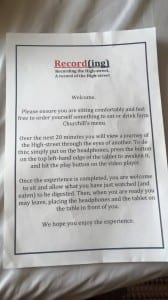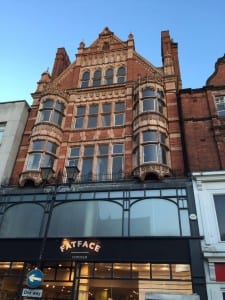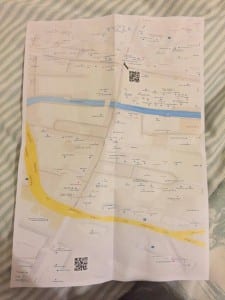Framing Statement:
For our piece, we invited audience members to watch a 20 minute ‘tour’ of the high street starting at Churchills’ café following the high street all the way down until just past the train lines. This however was not an ordinary tour. We created a facebook event where allocated times were posted and it was up to the audience to say which slot they would like. After they did this we then devised a timetable so we knew what times people would be coming in order to allocate ourselves breaks and organise for the tablet we used to be charged. The audience member received instructions over facebook (on the event) as to what to do next. The description of the event was as follows –
“Recording the high street.
A record of the high street.
If you would like to attend this performance please post your preferred allocated time on this page, performances are an individual experience and will occur every thirty minutes starting on the hour.
Please ensure you arrive promptly as late comers may miss their slot.
Upon arrival, enter Churchills and wait to be greeted by a member of staff. Please make sure you let the waiter/waitress know you are here to see Record. You will then be taken to your seat.”
When audience members arrived at the café, they were shown to their seat by the waitress (after we negotiated the café’s involvement within our piece). Once the audience member was seated the waitress took their order, food and/or drink, and the experience could begin.
After reading the ‘menu’ we created the audience member proceeded to put on the headphones provided and watch the video. This 20 minute video took people on a ‘tour’ of the high street from the comfort of a chair in a café, the film was shot from a point of view angle (POV) using a steady-cam camera and was shot in 4K HD (influenced by Janet Cardiff, but more about her later). Along the journey there was a constant sound track playing over the top of the video which were all artifacts we had found during the process of putting together our piece. These included a symphony from a classical album, an extract from a book called ‘Dames don’t care’ and instructions on how to start a car; all of which we found in the car park that comes in the middle of our piece. Once the audience member arrived at the car park in the video the audio track was then played in reverse as the camera went back up the high street to show how an experience of a place can be altered by small things such as music, we felt this gave a whole new feel to the environment. Once the video arrived back at the café, the audience member was then given a few extra minutes to relax and digest their experience and was told (on the instructions) that they could leave whenever they wanted, we wanted this experience to be a relaxing a reflective time for the audience member and we believe we achieved this.
Analysis of Process:
Friday 6th may 2016, it was our final performance. Because our performance didn’t require us to be actively involved in the piece it was a good time for us to reflect on our journey and the different events that led us to where we were.
Site specific performance, for me, is using the space around you in a unique and novel way to enhance the experience or change a person’s perspective on how they view a space. To alter the relationship between a person and a place is the essence of site specificity and this was what my group wanted to achieve from the very start. In the first few weeks we looked at numerous different practitioners such as John Smith and Tim Etchells from ‘Forced Entertainment’. One thing I noticed whilst studying these site specific practitioners is how they use everything within that space whether that is the buildings, people and also acts of randomness, Mike Pearson also mentions this in his introduction to site specific performance “Places are thus not so much fixed as implicated within complex networks by which hosts, guests, buildings, objects and machinery are contingently brought together to produce certain performance in certain places at certain times. Places are about relationships, about the placing of peoples, materials, images and the systems of different that they perform.” (Pearson, 2010)
The site were were given was the high street, we began to explore the high street as much as possible, ranging from the main strip down to hidden passages we had never noticed before. We began to think of different kinds of performance we could do in this space using Carl Lavery’s ‘Instructions for Performance in Cities’ (2005). After trying out different activities for Lavery’s document we decided that one of the things we found interesting was personifying the buildings around us. For this we assigned a certain sound to individual buildings, for example some buildings would let out a large sigh and some would let out a scream that sounded angry. These sounds then allowed us to develop characters for each building as they all sounded individual to us. The following week in class we watched a video called ‘girl chewing gum’ by John Smith, this video was a film of a normal street in England with a narrator over the top. Because the narrator took on a directorial role, it appeared he was controlling the action. For example, if a woman wearing a hat was to enter the screen he would say ‘woman wearing hat enter from left’ and so on. Because John picked out tiny moments in this film to narrate such as a girl chewing gum, we thought that noticing the un-noticed was an interesting idea that we wanted to include in our own piece. We walked around the high street yet again but this time looking out for the un-noticed, things that we walk past every day but are too caught up in the busy hustle and bustle of our hectic working lives to notice. We wanted to discover these hidden gems on the high street in order to give our audience a brand new experience of such an ordinary place they have visited numerous times. Not only did we look out for the un-noticed, we also tried viewing the high street from different angles such as stood on benches to see if this gave a different feel as we were experiencing the high street for the first time from the point of view!
After experimenting and having fun with our different activities we had developed we started to think about how we would present this performance, and like John Smith, we wanted to use technology (although ours would be more advanced). We thought about how we could use technology in a way that still gave an audience member a private experience, we then thought of QR codes. QR codes are square bar codes that you scan with smart pones that take you directly to an online link. We had decided to create a soundtrack made up of different interviews we had asked people. In these interviews the participants were asked a series of questions in a specific place, some of these questions were –
- What do you think this place used to be used for?
- If a significant event in your life happened here what would that be?
- What does this place sound like if it could make a noise?
After we had collected enough interviews in different locations we then made multiple sound tracks (relating to Lavery’s 10th instruction of creating a symphony) and allocated them to the corresponding QR codes, these QR codes were then sellotaped to the site. Audience members would find the QR codes by looking at a map they were given with tiny QR codes representing the location of the real codes.
Here are a few videos of our class trying out our initial performance –
After receiving feedback we discussed how we could further develop our piece by using images to make the piece more engaging for the viewer. We began doing some more research into site specific practitioners and found a woman called Janet Cardiff, using her work as inspiration we decided to change our piece from a stationary audio soundtrack to an audio and visual tour of the high street from a point of view perspective just like Cardiff’s ‘Alter Bahnhof video walk’. Using the influence of our two favorite practitioners (Cardiff and Smith) we began devising our final piece. We loved how Cardiff captured the site around her using a POV shot, this made the audience member feel more connected and because it was viewed through a smart film it almost looked as if the audience member was filming it themselves. However, in Cardiff’s work she has carefully placed performers working with her such as a band and a ballet dancer whereas we didn’t want that level of performativity in ours. We still really liked John Smiths acts of randomness as this enabled us to capture the natural beauty and buzz of the high street, combining the two practitioners gave us our final piece… Record(ing).
After discussing our ideas for the new audio/visual tour with our tutors we decided to keep the tour stationary. This is so the audience member could relax and be fully immersed in the experience from the comfort of one place, also so they didn’t have to hold a smart phone at eye level for 20 minutes as this would be extremely uncomfortable! As our group had spent a lot of time in Churchill’s café having meetings (and breakfast) we decided to have Churchill’s as the place where our audience would watch the tour. After much negotiating with Churchill’s staff and attempts to negotiate with the owner (although we never received an email back from him) we were able to secure two tables for the day of our performance. One for the audience member to watch the tour at and one hidden upstairs so we were out of view as we didn’t want to be in the final performance as that would have added a new level of performativity, we simply stayed in the café for security for the tablet and headphones we had provided so people could watch our piece. ‘Robinson in Space’ by Patrick Keiller was another inspiration for us as this was a beautifully shot film with narration over the top, the inspiration we took from this piece was incorporating the sound of birds when there was speech. Artifacts we had found in the car park in the middle of our film were recorded and edited together to make our soundtrack, this included an extract from a book called “Dames Don’t Care”, instructions we had found on a scrap piece of paper on how to start a car and the album cover for Symphony No.9 by Anton Bruckner. The soundtrack was a continuous and flowing piece of art carefully designed to relate to certain points in our film, for example when the camera looked at a church the music switched key to one more obviously Minor, and when the camera looked back to the high street switched back to major key thus provoking a more positive feel to the piece.
Our aim was to create a piece of art that altered a persons relationship with our site, through the careful design of the soundtrack, beautiful focus points in our film and the chance to take in the experience of the high street from the comfort of a café I believe we achieved this. Our film has turned what was once a regular high street into a piece of art for those who have seen our site specific piece, our work “incorporates documentation precisely in order to address the paradoxical relationship between its construction of a work and the site it seeks to uncover” (Kaye, 2000).
Performance Evaluation:
In reflection upon our piece of work, it is rewarding to see all the positives that came from our hard work, yet also rewarding to see our failures as this gives us the opportunity to grow as young artists and practitioners.
Things that worked well in our piece –
- The camera we used was excellent; it was a steady cam which meant by using gyroscopes in the machinery, the camera automatically steadied itself creating an extremely smooth show which was easy on the audience’s eye. Not only was it incredibly smooth, it was also shot in 4K HD which meant it was crystal clear too enhancing the rich colour and sights of the high street.
- Using the environment of the café worked extremely well as it placed the audience in a situation where they felt comfortable, warm and could digest food and drink out of a large selection to better enhance the experience.
- Having only one person at a time made the experience more personal as it felt as if it really was his or her own journey down the high street. Not only this, but being on your own without distractions from friends or other audience members allowed participants to become fully immersed in the video.
- Using artifacts we had found to create the soundtrack made the video more unique as it wasn’t like any song the audience member had heard before as we created it ourselves. This also made the video strikingly more artistic as the soundtrack had been carefully designed to relate to visuals on screen.
Things that we would improve for next time –
- Unfortunately the computers we used to edit the video simply weren’t good enough for the quality of camera. Because the camera was on loan to us from an events company we were only able to get hold of the camera the Tuesday before our performance (the Friday). Because of this short space of time we had to film, we tried (and failed) many different techniques of editing the video ranging from 3 different computers and trying to compress the file to a worse quality so our computers could cope with it. Finally it got the point where we had to gain access to an editing suite at University and stay in there until 3 in the morning one night. Without a doubt next time we would try using the correct computers to edit in the first place.
- As we didn’t have performers in our piece and everything that took place in the video were acts of randomness, different shoots led to different events taking place. One of our shoots on the second day of filming was perfect; we had beautiful weather, a busy high street, musical buskers interacting with the camera, constant stopping and starting because of traffic all making the video extremely interesting to watch! Unfortunately right near the end of filming the camera ran out of room on the memory card so stopped filming and because we wanted the video the be taken In one take to make it as smooth as possible we had to reshoot meaning we lost all of the unique and beautiful moments.
Record(ing) the Final Piece…
Here is our final piece that we uploaded to youtube for those who didn’t manage to see our performance on the day.
This experience has opened my eyes to an entirely new world of performance, a world that I wish to explore more as I develop as a young practitioner. As an artist I no longer see performance to be something contained in a traditional environment such as a stage, performance can happen and is happening anywhere and everywhere all the time.
Totus Mundus Agit Histrionem… All the worlds a stage…
Joshua Pearson.
Bibliography –
Kaye, N. (2000) Site Specific Art: Performance, Place and Documentation. London: Routledge.
Pearson, M. (2010) Site-Specific Performance. London: Palsgrave Macmillan.
Lavery, C. (2005) Teaching Performance Studies: 25 Instructions for Performance in Cities.












